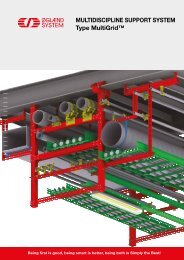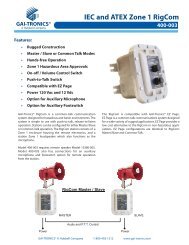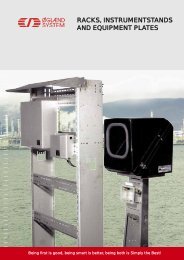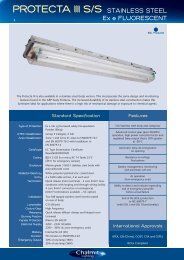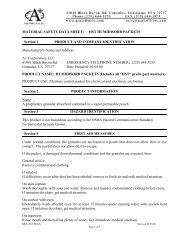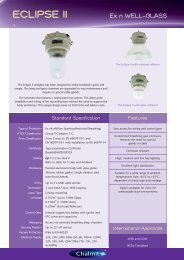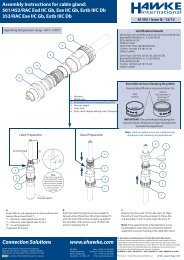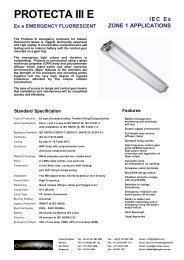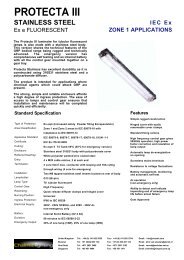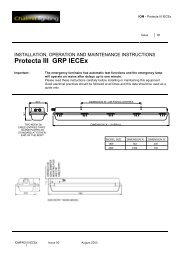Newsletter Issue 21 - JT Day Pty Ltd
Newsletter Issue 21 - JT Day Pty Ltd
Newsletter Issue 21 - JT Day Pty Ltd
Create successful ePaper yourself
Turn your PDF publications into a flip-book with our unique Google optimized e-Paper software.
Why earthing is important<br />
By Paul Hollingsworth, CEO Lightning Protection International<br />
The installation and maintenance of<br />
an effective low resistance earthing<br />
system is essential for any modern<br />
facility for three key reasons:<br />
▪▪<br />
▪▪<br />
▪▪<br />
Protection of personnel<br />
Protection of equipment<br />
Ensuring electrical noise reduction to<br />
minimise voltage potentials between<br />
interconnected equipment<br />
The requirement for effective earthing is<br />
critical when considering the following<br />
applications:<br />
▪▪<br />
▪▪<br />
▪▪<br />
▪▪<br />
Lightning protection<br />
Power generation, distribution and<br />
transmission<br />
Telecommunications<br />
Reduction of static electricity<br />
The key parameters of an efficient<br />
earthing system<br />
In order to achieve a low resistance and<br />
impedance, earth connections should be<br />
short and direct as possible.<br />
Maximising the surface contact between<br />
the soil and all electrodes and conductors is<br />
essential for efficient performance.<br />
The system needs:<br />
▪▪<br />
▪▪<br />
▪▪<br />
▪▪<br />
▪▪<br />
Excellent electrical conductivity<br />
Low earth resistance and impedance<br />
Conductors capable of withstanding high<br />
fault currents<br />
Robust mechanical connections to<br />
facilitate a long working life<br />
High corrosion resistance<br />
Materials chosen for earthing systems should<br />
offer an acceptable compromise between<br />
cost and longevity. Compatible metals must<br />
be used to minimise corrosion.<br />
▪▪<br />
Equipotential Bonding<br />
The elimination of dangerous step and touch<br />
potentials is achieved through equipotential<br />
bonding of all earths.<br />
The importance of low soil<br />
resistivity<br />
The resistance of the earth itself (earth /<br />
soil resistance) is the greatest influence<br />
on overall impedance of an earthing<br />
system.<br />
Factors such as soil composition, moisture<br />
content, seasonal weather, mineral content<br />
and possible contaminants determine<br />
resistivity.<br />
Moisture content is the single largest<br />
influence and in most cases, the higher the<br />
moisture level the lower the soil resistivity.<br />
The installation of a deep driven earthing<br />
electrode that reaches the water table<br />
beneath the surface represents an ideal<br />
earthing system.<br />
▪▪<br />
▪▪<br />
▪▪<br />
Rich dark soils high in organic content<br />
are typically good conductors due to<br />
moisture retention which aids in the<br />
dissipation of electrical currents.<br />
Sandy soils are ineffective in retaining<br />
moisture and typically have higher<br />
impedance.<br />
Rocky ground retains virtually no<br />
moisture and is very high in resistance.<br />
Designing an earthing system<br />
There are several factors to consider<br />
when planning the design of an earthing<br />
system.<br />
▪▪<br />
Applicable standards and codes to be<br />
followed:<br />
For power system earthing IEEE 80 or other<br />
international derivations are widely used.<br />
These standards are usually mandatory<br />
and some level of expertise is needed to<br />
undertake designs to these standards.<br />
For lightning protection / static earths<br />
commonly used standards are IEC62305,<br />
AS1768, NFPA 780. These are often not<br />
mandatory but provide recommendations.<br />
▪▪<br />
▪▪<br />
▪▪<br />
▪▪<br />
▪▪<br />
▪▪<br />
▪▪<br />
▪▪<br />
▪▪<br />
▪▪<br />
Type of facility and the site layout in<br />
regards to available space<br />
Level of soil resistivity at site<br />
Influence of seasonal weather conditions<br />
on soil resistivity<br />
Corrosive nature of soil and<br />
consequently materials chosen for use<br />
Expected life of the facility will affect<br />
material choices<br />
Future extensions<br />
If applicable the status of any existing<br />
earthing system<br />
Step and touch potentials<br />
Volume of pedestrian traffic<br />
Finally, but most importantly, the quality<br />
and compliance of hardware used in<br />
the earthing system installation is a<br />
major determinant of the reliability of the<br />
earthing system.<br />
This is why some standards for design also<br />
have requirements associated with testing<br />
and certification of components. Some<br />
applicable testing standards include IEEE<br />
837, and EN 50164.<br />
Footnote:<br />
<strong>JT</strong> <strong>Day</strong> has signed a distribution agreement with LPI for earthing/direct strike<br />
products for the oil & gas market.<br />
Reliability Dependability Quality<br />
3



